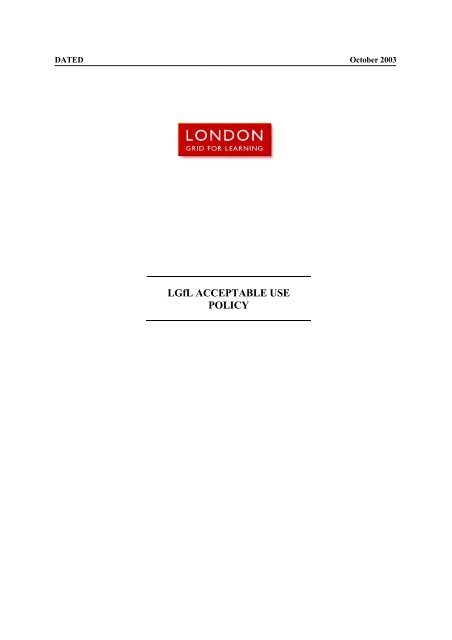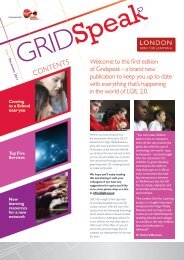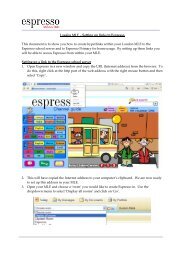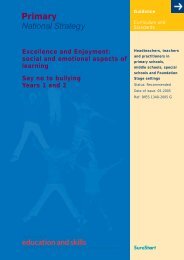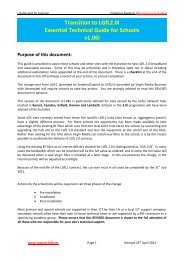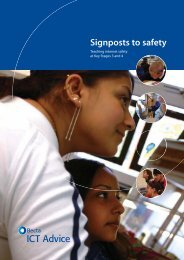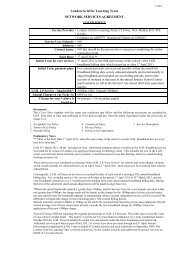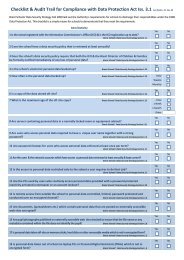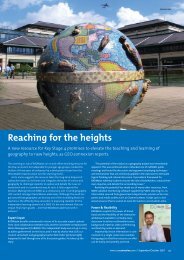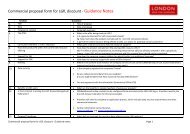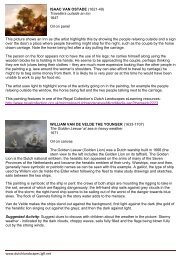LGfL Acceptable Use Policy.pdf
LGfL Acceptable Use Policy.pdf
LGfL Acceptable Use Policy.pdf
You also want an ePaper? Increase the reach of your titles
YUMPU automatically turns print PDFs into web optimized ePapers that Google loves.
DATED October 2003<strong>LGfL</strong> ACCEPTABLE USEPOLICY
CONTENTS1. BACKGROUND ....................................................................................................................... 22. ACCEPTABLE INTERNET USE GUIDELINES .................................................................... 23. UNACCEPTABLE USAGE GUIDELINES FOR THE INTERNET ....................................... 34. DATA PROTECTION............................................................................................................... 45. LIABILITY ................................................................................................................................ 56. INFORMATION ON THE WORLD WIDE WEB ................................................................... 57. GUIDELINES FOR ELECTRONIC MAIL USE ..................................................................... 68. LGFL ANTI VIRUS POLICY ................................................................................................... 8DAC/ER/62801/120001/2378079 1
1. BACKGROUND1.1 This acceptable use policy ("AUP") describes acceptable use of the London Grid forLearning ("<strong>LGfL</strong>") by the organisation ("Connecting Organisation"), whichconnects to the <strong>LGfL</strong> for the purpose of providing educational, governmental andother related services to students ("<strong>Use</strong>rs").1.2 <strong>Use</strong> of the Internet and <strong>LGfL</strong> mandated services, such as the electronic mail service,are primarily intended for educational and government purposes only. [The <strong>LGfL</strong>may not be used for commercial or financial gain without obtaining our prior expresswritten approval from <strong>LGfL</strong>]1.3 We recommend that Internet use in educational establishments is driven by clearlearning intentions that are set in the context of well framed tasks.1.4 It is the responsibility of the Connecting Organisation to ensure that its employeesand all <strong>Use</strong>rs are required to follow all the conditions laid down in this AUP.1.5 Connecting Organisations must have in force an acceptable use policy whichemployees of the Connecting Organisation, and <strong>Use</strong>rs (and where a <strong>Use</strong>r is below theage of sixteen, the <strong>Use</strong>r's legal guardian) are fully aware of in order to regulate theuse of the Internet via the <strong>LGfL</strong>, and which seeks to enforce all of the conditionswhich are laid down in this AUP.2. ACCEPTABLE INTERNET USE GUIDELINES2.1 <strong>Use</strong> of the Internet outside of the scope of this AUP (as set out in paragraph 1.2)should be agreed [within the Connecting Organisation] and will be subject to thesame guidelines and policies as though the <strong>Use</strong>r is using the <strong>LGfL</strong> for the purposesset out in paragraph 1.2.2.2 <strong>Use</strong> of the Internet by <strong>Use</strong>rs must be supervised by an appropriate employee of theConnecting Organisation, and the Connecting Organisation must take steps tomonitor, and where appropriate, record this usage.2.3 The Connecting Organisation must ensure that access by <strong>Use</strong>rs who are under the ageof sixteen should always be in areas where screens are visible to the supervisingemployees of the Connecting Organisation.2.4 Connecting Organisations must ensure that <strong>Use</strong>rs are not given access to Newsgroupsor 'chat areas' unless using areas specifically designed for safe use and they aresupervised by an appropriately qualified employee of the Connecting Organisation.2.5 Connecting Organisations must ensure that <strong>Use</strong>rs do not give out personal detailsover the Internet except in circumstances (e.g. joint projects), which the ConnectingOrganisation has approved. We recommend that 'Web names' are a useful way ofshielding real identities.2.6 Connecting Organisations must keep its anti-virus software up to date and complywith the obligations set out in paragraph 8 of this AUP to ensure that activities are notdisrupted by malevolent actions by others.\LGFL ACCEPTABLE USE POLICY 0310.DOC (\c) 2
2.7 Employees of Connecting Organisations receiving questionable materials shouldreport these immediately to the appropriate member of their organisation and, whereappropriate, that person should forward details of such materials to filtering@lgfl.net.2.8 All Connecting Organisations must make <strong>Use</strong>rs aware that all access is logged, andthat any material accessed may subsequently be viewed by other <strong>Use</strong>rs as well asbeing monitored by the Connecting Organisation and/or the <strong>LGfL</strong> systemadministrator.2.9 Connecting Organisations must ensure that its personal computers (includingportables) may only be used to access the <strong>LGfL</strong> using the mandated routing and intersite policies.2.10 Any software downloaded from the Internet by the Connecting Organisation or any<strong>Use</strong>r must be appropriately virus checked, licensed and registered.3. UNACCEPTABLE USAGE GUIDELINES FOR THE INTERNET3.1 It is contrary to this AUP for any Connecting Organisation to allow its employees or<strong>Use</strong>rs to use the <strong>LGfL</strong> for any of the prohibited acts ("Prohibited Acts") set out inparagraphs 3.1.1 to 3.1.14 below. Each of the Prohibited Acts, whether carried out byan employee of a Connecting Organisation or a <strong>Use</strong>r, may lead to a termination of theConnecting Organisation's agreement with us for connection to the <strong>LGfL</strong>:3.1.1 access to or creation, transmission or publication of any offensive,obscene or indecent images, sounds, data or other material;3.1.2 a breach of confidentiality that results in information beinginappropriately displayed or made available to others;3.1.3 access to or creation, transmission or publication of any data capable ofbeing displayed or converted to such obscene or indecent images, sounds,data or other material;3.1.4 the creation, transmission or publication of any material which is designedor likely to cause offence, inconvenience or needless anxiety;3.1.5 the creation, transmission or publication of defamatory, violent, abusive orhomophobic material;3.1.6 receipt or transmission of material such that this material infringes thecopyright of another person;3.1.7 transmission of unsolicited commercial or advertising material to otherusers of the Internet or any other network reachable via the Internet;3.1.8 deliberate unauthorised access to facilities, services, data or resourceswithin the Connecting Organisation, any other network or serviceaccessible via the Internet;3.1.9 deliberate activities with any of the following characteristics or that bytheir nature would result in:\LGFL ACCEPTABLE USE POLICY 0310.DOC (\c) 3
3.1.9.1 wasting the Connecting Organisation's employees or other <strong>Use</strong>rsefforts or network resources, including time on remote systems andthe efforts of the Connecting Organisation's employees involved inthe support of those systems;3.1.9.2 corrupting or destroying other <strong>Use</strong>rs' data;3.1.9.3 violating the privacy of other <strong>Use</strong>rs;3.1.9.4 disrupting the work of other <strong>Use</strong>rs;3.1.9.5 using the Internet in a way that denies service to other <strong>Use</strong>rs (forexample, by overloading the connection to the network byunnecessarily, excessively and thoughtlessly downloading oruploading large files);3.1.9.6 continuing to use any item of software after being requested to ceaseits use because it is disrupting the correct functioning of theConnecting Organisation's network or the Internet (for example,utilities designed to broadcast network-wide messages);3.1.10 malicious, wilful or reckless use of the Internet having the intent or theeffect to:3.1.10.1 gain unauthorised access to computer material;3.1.10.2 gain unauthorised access to computer material with the intent tocommit or facilitate the commission of any further offence;3.1.10.3 demand material from a user of another computer system;3.1.11 the introduction of viruses;3.1.12 where the Internet is being used to access another network, any abuse ofthe acceptable use policy of that network;3.1.13 any use of the Internet that would bring the name of the ConnectingOrganisation and/or the <strong>LGfL</strong> into disrepute; or3.1.14 purchasing or ordering items on the Internet without the appropriateauthorisation or due regard to the financial policies and procedures of theconnecting organisation.4. DATA PROTECTION4.1 The Connecting Organisation must ensure that receipt or transmission of material byits employees or any <strong>Use</strong>r:4.1.1 should not disclose the identity of any living person without that person'sconsent;\LGFL ACCEPTABLE USE POLICY 0310.DOC (\c) 4
4.1.2 which identifies a living person should not be transmitted outside theEuropean Economic Area unless it is to a country that has in place laws toprotect the confidentiality, security and use of that information that equateto those found in the European Economic Area or under the terms of awritten agreement that provides such protection. In either case thatperson's consent is required.5. LIABILITY5.1 Connecting Organisations are solely responsible and <strong>LGfL</strong> accepts no liability for theuse, content and messages that a Connecting Organisation, its employees or <strong>Use</strong>rspost, distribute or otherwise make available using the <strong>LGfL</strong>5.2 We accept no liability for any orders for goods and/or services, which a <strong>Use</strong>r placesover the Internet when using the <strong>LGfL</strong>.5.3 You agree to indemnify us against all claims, losses, liabilities, costs (including legalcosts) and expenses which we may incur as a result of any breach of your obligationsin this AUP or the use or misuse of the <strong>LGfL</strong>.6. INFORMATION ON THE WORLD WIDE WEB6.1 Connecting Organisation's are reminded that publishing material on the world wideweb makes it widely available and that as such due care and diligence must be takenby the Connecting Organisation to ensure that any communication via this mediumby the Connecting Organisation, its employees or its <strong>Use</strong>rs is regulated.6.2 Connecting Organisations are advised when designing web sites to avoid publishingpictures of individual pupils with personal information about them. This will ensurethat their privacy is protected and ensures that strangers will not be able to approachthem outside school with information they have taken from the ConnectingOrganisation's web site. Where decisions are made to include images of individualchildren under the age of sixteen then this must be authorised by the legal guardian ofthe child.6.3 One or more employees of the Connecting Organisation should take responsibility forvetting data before it is uploaded to an <strong>LGfL</strong> web site to ensure the data is in linewith local policies and best reflects the character of the Connecting Organisation. Aspart of this process the Connecting Organisation will also be responsible for ensuringthat the ownership, accuracy and copyright of the material are appropriate prior topublication.6.4 The web site should reflect the work of the Connecting Organisation and web authorsshould attempt to seek contributions from all teachers, year groups, head teacher,governors, parents and the local community.6.5 Most good web publishing software have spellcheckers. It is advisable to ensure thatwork is spell checked before uploading to a server or the Portal.6.6 <strong>Use</strong>rs are encouraged to write material in ‘Plain English’\LGFL ACCEPTABLE USE POLICY 0310.DOC (\c) 5
6.7 When using images from other sites it is advisable to seek permission first. This canbe done by sending an Email to the contact name on the web site. ConnectingOrganisations are reminded of their obligation in paragraph 3.1.6.6.8 Connecting Organisation's should note that any data originating from theirorganisation or relating to business conducted by, or on behalf of them, and which istransmitted by the Internet remains the property of the Connecting Organisation. andthat the copyright or other intellectual property rights attached to that data areunaltered in any way.6.9 The Connecting Organisation must respect the privacy and confidentiality of any dataor other material published on the Internet and must be mindful that same restraintsapply to the Internet based communication as to any other medium.6.10 <strong>LGfL</strong> recommend that each page of the web site should be consistent in terms ofdesign, layout, graphics and fonts. This will make it easier for <strong>Use</strong>rs to read andnavigate the site.7. GUIDELINES FOR ELECTRONIC MAIL USE7.1 Connecting Organisations must abide by the following code of conduct.7.2 Connecting Organisations must:7.2.1 ensure that procedures are in place to ensure that inbound and outboundmail is virus free, and ideally, can identify and block the transmission ofunsuitable information.7.2.2 encourage its employees and <strong>Use</strong>rs to regularly housekeep e-mail deletingmail that is no longer required;7.2.3 not, and ensure that its employees and <strong>Use</strong>rs do not, transmit personalisedor financial data over the Internet unless it is encrypted or appropriatelyscrambled;7.2.4 report and ensure that its employees and <strong>Use</strong>rs report unsolicited mail(“spamming”) to filtering@lgfl.net;7.2.5 ensure that its employees and <strong>Use</strong>rs do not delegate digital signatures orelectronic pin numbers / identifiers to colleagues;7.2.6 ensure that its employees and <strong>Use</strong>rs make arrangements for ensuring thate-mail is forwarded to a trusted colleague in an employee's or <strong>Use</strong>r'sabsence to ensure that important messages and transactions are not lost.(However, <strong>Use</strong>rs and employees of Connecting Organisations shouldNEVER redirect mail without advising such colleagues first!);7.2.7 encourage its employees and <strong>Use</strong>rs do not to print e-mail unnecessarily, asthis will minimise the environmental benefits of using electroniccommunication. (The exception is e-mail that may be used in legalproceedings which should be printed off as mail administrators may haveprocedures which automatically remove mail that has been read after a setnumber of days);\LGFL ACCEPTABLE USE POLICY 0310.DOC (\c) 6
7.2.8 discourage inappropriate use of the courtesy copy function by itsemployees and its <strong>Use</strong>rs. Mail should only be copied to those parties thathave been involved in previous communication and need to be involved inthe communication process;7.2.9 discourage employees and <strong>Use</strong>rs from sharing common mail accounts;7.2.10 ensure that its employees and <strong>Use</strong>rs clearly identify confidential mailitems as such (e.g. in the subject field);7.2.11 encourage employees and <strong>Use</strong>rs to carefully check emails before sending;7.2.12 ensure that its employees and <strong>Use</strong>rs avoid expressing strong feelings ofdisagreement in public forums (use an individual's private mail box);7.2.13 ensure that its employees and <strong>Use</strong>rs are made aware of copyrights andlicences and are careful not to breach them;7.2.14 ensure that its employees and <strong>Use</strong>rs ask permission before forwarding orcopying other people's messages;7.2.15 avoid and ensure that its employees and <strong>Use</strong>rs avoid sexist, racist, violent,abusive and homophobic language as would be expected in any othercontext;7.2.16 ensure that its employees and <strong>Use</strong>rs avoid writing messages using ALLupper case letters;7.2.17 ensure that if the message is very important, controversial or open tomisunderstanding, the Connecting Organisation, its employees or any<strong>Use</strong>r must consider a face to face discussion or a telephone conversationinstead;7.2.18 ensure that its employees and <strong>Use</strong>rs select the right forum for discussion -private mail or conference;7.2.19 ensure that it, its employees and <strong>Use</strong>rs, when joining a conference whichhas been in existence for some time, read through all the contributions todate to avoid asking a question or making a point which has already beenmade; and7.2.20 Connecting Organisations should consider putting a standard disclaimeron e-mail;7.3 To make sure messages are read the Connecting Organisation must encourage itsemployees and <strong>Use</strong>rs:7.3.1 to make sure the title of a message is relevant and if starting a new topic,change the subject line;7.3.2 to get to the point quickly, as this way more people will read the message;7.3.3 to keep messages short; and\LGFL ACCEPTABLE USE POLICY 0310.DOC (\c) 7
7.3.4 to use short paragraphs as they are easier to read on screen. Double linespaces between paragraphs help, and bulleted or numbered lists are a goodway to display separate ideas.8. LGFL ANTI-VIRUS POLICY8.1 Introduction8.1.1 This policy document outlines responsibilities and methods for ensuringthat Connecting Organisations do not jeopardise the integrity and securityof the computer systems in the <strong>LGfL</strong>. All employees of ConnectingOrganisations should be aware of the guidelines and recognise thatbreaching them may result in disciplinary action by the ConnectingOrganisation.8.1.2 Connecting Organisations must ensure that their systems are protected byanti-virus measures, that processes are in place to ensure the anti-virussystems are kept up to date in line with supplier recommendations and thatthe organisation has the technical capability to maintain its anti-virussystem.8.1.3 Malicious software can be categorised into five main types of code,namely Viruses, Logic Bombs, Trojan Horses, Worms and Hoaxes:8.1.3.1 Virus type code attaches itself to a program (as opposed to data) fileon a disc, or onto the “boot sector” which is read by the PC when itfirst starts up8.1.3.2 Logic Bombs are activated when certain criteria are met, e.g. thedate being Friday 13 th ;8.1.3.3 Trojan Horses are contained within, as opposed to attached to,existing software (including viruses) and cause extra instructions tobe executed, for example copying usernames and passwords to ahidden file which the perpetrator can access later in order to breachsecurity; and8.1.3.4 Worm code is similar to Virus code but is able to exist on its own(i.e. without being attached to another file). Worms replicatethemselves, and then destroy the “mother copy”, which gives theimpression that the software is moving about the disc, until the disceventually fills up.8.1.3.5 Hoax Virus-Warnings. These are messages sent out to usersrequesting that they warn (i.e. forward the message to) everyone intheir address book and are based on similar principles as a chainletter.8.2 Sources of Virus Infection8.2.1 Research has shown that Viruses tend to be written by students, computerhobbyists or disgruntled employees. The latter group directing their\LGFL ACCEPTABLE USE POLICY 0310.DOC (\c) 8
attacks specifically at their employer’s (or former employer’s)organisation.8.2.2 The vast majority of viruses are unwittingly introduced to an organisationfrom an external source. Common routes are:8.2.2.1 discs brought in from home;8.2.2.2 unsolicited e-mails;8.2.2.3 free software from PC magazines;8.2.2.4 demonstration and evaluation software;8.2.2.5 websites with malicious code on;8.2.2.6 files and software downloaded from the Internet; and8.2.2.7 engineer’s discs.8.2.3 Once introduced, viruses are easily transferred from one PC to another bymeans of a floppy disc or as email attachments.8.3 Guidelines For Preventing Corruption Or Loss Of Data Through ComputerViruses8.3.1 All Connecting Organisations must have anti-virus software installed andhave procedures in place to keep the software up to date.8.3.2 All new computers purchased must be certified virus-free on delivery.8.3.3 All ICT contractors on a Connecting Organisation's site will be expectedto work within the <strong>LGfL</strong> guidelines and should use virus free software anddisks.8.3.4 The Connecting Organisation must have procedures in place for ensuringthat anti virus software is updated on a regular basis.8.3.5 All existing PC’s must have recommended anti-virus software loaded andscanning enabled for both the hard drive and the floppy disk.8.3.6 Until such time as all PC’s within a given area have Anti-Virus enabled, itis the responsibility of the Connecting Organisation to have a stand-alonePC available for the validation of all incoming discs and CD-ROMS.8.3.7 PCs used from home to connect directly to the <strong>LGfL</strong> or resources withinthe <strong>LGfL</strong> must have anti-virus software loaded and scanning enabled.8.3.8 All incoming discs must be scanned prior to loading either automaticallyor through the stand-alone system designated for this purpose.8.3.9 Software must only be purchased from the approved suppliers or inaccordance with Connecting Organisation procedures and must becertified virus-free.\LGFL ACCEPTABLE USE POLICY 0310.DOC (\c) 9
8.3.10 Blank discs must only be purchased from suppliers who certify that theyare virus-free.8.3.11 Unsolicited or unauthorised software must not be loaded on theConnecting Organisations computers.8.4 Elimination of Virus Infection8.4.1 On detection of a virus infection, employees of the ConnectingOrganisation must immediately take steps to contain the virus and preventits spread outside the Connecting Organisation.8.4.2 Any virus infections on Connecting Organisation's system should berecorded. The record should contain the date of the infection, the virusencountered, the PCs affected and where possible identify the source ofthe virus.8.4.3 The infected system must be immediately disconnected from the <strong>LGfL</strong>.8.4.4 Disinfection of virus-infected systems must only be carried out by suitablyqualified staff within the schools.\LGFL ACCEPTABLE USE POLICY 0310.DOC (\c) 10


